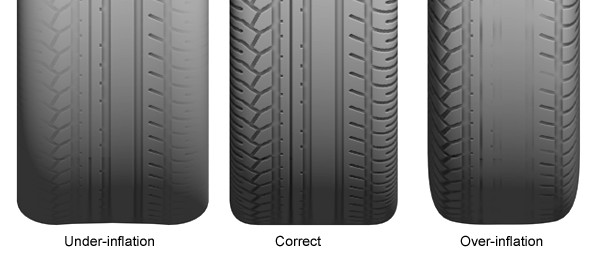It’s all too easy to forget about the condition of your car’s tyres, at least until something looks or feels like it’s wrong with one of them. If you’re a driver who leaves vital tyre checks until a tyre starts to look a bit deflated, you’re almost certainly wasting cash through premature tyre wear. More importantly, you could be putting yourself and others at risk on the road.
Tyre condition is hugely important for the safety, fuel economyand handling of your car. Even without a puncture, tyres can gradually seep air over time, so it’s vital to check that all four tyres are at the correct pressure on a regular basis. (Your handbook probably says tyre pressure checks are a weekly requirement, and no expert would advise leaving tyres unchecked for more than a month.)
How to check your car tyre pressures
Tyre pressure is measured using two units: bar (where 1 bar is the pressure of the Earth’s atmosphere at sea level) and pounds per square inch (shortened to psi). Most gauges will display both units, and so will your car’s handbook, which lists the recommended pressures. Most cars also have a sticker or plate on the inside of one of the doorframes with a table of pressures.
To check your pressures, you need to find each wheel’s tyre air valve, which is a small tube on the inner rim of the wheel. Each one should have a little plastic screw-on cap (called a dust cover), which you can easily unscrew by hand. Make sure you place it somewhere safe and don’t forget to screw it back on tightly when you’re finished.
Once the dust cap is off, you can place your pressure gauge over the valve, push it in slightly and hold it for a few seconds. A pressure reading should appear on the gauge’s dial or screen.
If any of your tyres aren’t at the correct pressure, the machines on garage forecourts can be programmed to pump them up – you simply input the correct pressure and it does the rest. If you’re at home, you can use a powered or foot-operated air pump to add air to the tyre, then check the pressure again to verify you’ve put enough in.
How to check tyre tread depth and condition
While you’re checking your tyre pressures, you should give them a visual inspection as well. Look for any nails or other sharp objects that may have become stuck in the tread, and watch out for any odd-shaped bulges in the tread surface or sidewall of the tyre.
If you do spot anything, head to a tyre centre or garage straight away, as damaged tyres like this can blow out without warning, potentially causing you to lose control of your car.
You should also pay close attention to your tyre tread depth. The law requires a minimum tread depth of 1.6mm in a continuous band around the central three quarters of the tyre. You can check the tyre’s tread depth with a tyre tread depth gauge but for a quick visual check, manufacturers often mould little bars into the tread at a height of 1.6mm.
When the main tread blocks wear down to the height of the little bars, it’s time for a new tyre. Of course, we would always recommend changing your tyres well before they reach the legal minimum tread depth.

